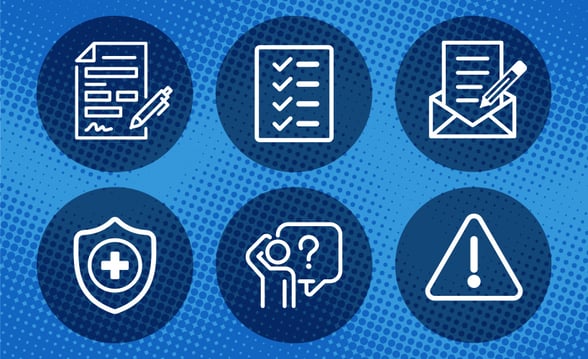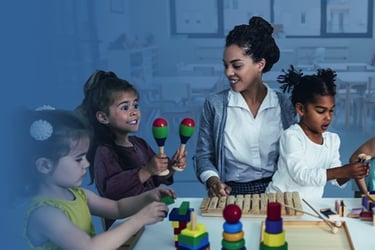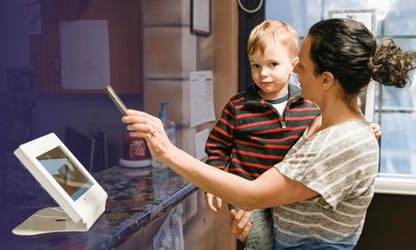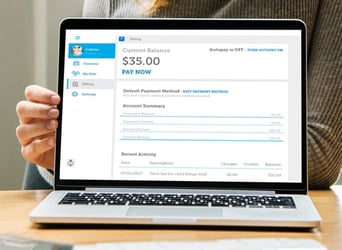Preschool Classroom Layout: Tips for a Functional Space
The layout of a preschool classroom plays a huge role not just in learning, but how kids behave and interact with one another in this setting. It teaches them crucial lessons about, behavior moderation, social interaction and expectations. This guide will dig into the far-reaching effects of choosing the right preschool classroom layout, provide tips for choosing the best preschool classroom layout ideas for your learning space and walk you through implementing it in order to set the stage for the kids in your care to thrive and learn. Research has shown that the elements of classroom design for preschool, including seating arrangements, wall decorations, lighting, temperature, acoustics and air quality accounted for 16 percent of the variation in students' academic progress, so these efforts are well worth the time. Creating a functional preschool space is easier than you think, so let’s get started.
Table of Contents
- Key Elements of an Effective Preschool Classroom Layout
- Best Preschool Classroom Layout Ideas
- Creating a Safe and Stimulating Learning Environment
- Budget-Friendly Classroom Setup Tips
- FAQs
- How Vanco Supports Preschool Educators Including 100+ Free Templates!
Key Elements of an Effective Preschool Classroom Layout
While classrooms vary from school to school and some have more room than others, there are key elements any preschool classroom needs in order to function well and help students progress in their educational journey. These elements are built on core concepts that focus on supporting and developing young minds as they begin their educational journeys and start a lifetime of learning.
Defined Learning Centers

Expectations are a must for young children, especially those getting used to the classroom environment for the first time. Clearly defining learning center arrangements for preschoolers by creating physical barriers that delineate spaces helps children understand what area of the classroom they’re in, what’s expected of them there and how to behave in each particular space. You can use a range of objects to help demarcate these spaces and decorate each to make it distinct and easy to recognize:
- Rugs
- Small dividing walls
- Shorter furnishings
- Colorful signs and posters
- Special seating
Why structured areas improve engagement and focus
Structure is central to preschoolers’ learning because it improves engagement and focus. Consistent, predictable early childhood learning spaces, schedules and routines can boost independence, improve ability to anticipate change and increase focus. When students clearly understand what each area of the classroom is for and how to behave there, it removes variables and allows them to devote more energy and attention to what they’re learning in a given space.
Common preschool learning centers
Every classroom has its own look and feel, but six common learning centers are fixtures in virtually every preschool. They’re all designed to support a different aspect of student’s development, with each playing a key role:
- Art Center: Students can use various materials, including markers, crayons, paint and clay for open-ended, imaginative activities that foster creativity and develop their fine motor skills.
- Drama/Pretend Play Center: Kids get to enjoy costumes, puppets, paper plates, dolls and other items to create their own original scenes, settings and interactions, helping grow their social abilities as well as their emotional intelligence in a play-based learning environment.
- Construction Center: Encourage your young minds to use LEGOs, various manipulatives and age-appropriate toy tools to build structures and objects that develop their spatial reasoning and problem-solving skills.
- Reading/Writing Center: As they’re working on building their basic reading skills, kids can enjoy a comfy corner
- Creates a cozy spot for engaging with books, audiobooks and early writing materials including alphabet puzzles and magnetic letters.
- Science/Discovery Center: Equipped with tools like magnifying glasses, scales and prisms for exploration and experimentation, often housing class pets.
- Math/Numbers Center: Contains manipulatives and games that develop early numeracy skills.
Each center should be thoughtfully stocked with age-appropriate materials that encourage exploration in a play-based learning environment while reinforcing skills and concepts being taught in the curriculum.
Open Spaces for Movement and Play
Obviously, younger children need room to move freely, run, jump and play. They have tons of energy and while there are times you want the kids in your classroom to focus on things you’re trying to teach them, it’s important that they have areas where they can be their high-energy selves. Not every classroom has an abundance of free space or easy access to safe outdoor play areas, but these steps will help no matter the classroom:
- Put safety features in place, including soft surfaces like sand (outdoors) or soft carpet or rubber mats (indoors), to minimize injury risks during active play
- Encourage free movement by maintaining clear pathways and ensuring equipment is well-spaced to allow easy navigation around the play area.
- Have clear, easily understood signals or words that allow children to know if they need to stop what they’re doing or listen for further instructions
- Provide kid-friendly, soft toys to use during free play, such as bouncy balls, foam pool noodles, etc.
Importance of free movement for physical development
Preschool-age children are growing quickly and need to ensure their physical development is supported by moving regularly, strengthening their muscles and working on aspects of coordination that will benefit them as they grow older. Studies show that early gross motor skills are essential for cognitive and physical development. Moving regularly helps establish neural pathways in the brain, supporting both motor coordination and cognitive functions like memory and processing speed.
Balancing active and quiet areas
As much as active play areas are a must in preschool classrooms, quiet areas are just as important. When they’re not playing or actively learning new educational concepts, kids need quiet areas where their brains can settle and they can calm down without being overloaded with noise and other types of stimulation. Without these types of spaces, you may find that behavior throughout the school day is affected and it’s harder to get children to focus and listen when needed.
Clear Traffic Flow and Organization
A preschool classroom can often feel a lot like a busy road system – people moving in various directions, having to stop, change direction and navigate around one another to safely reach their destination. It’s why you’ll often see rugs or mats with drawings of roads or paths on them to help students make their way from place to place within their classroom. These simple steps can help establish safe, efficient traffic flow and organization:
- Optimize Storage Solutions: Use labeled bins, baskets and shelves to categorize and store materials. Make sure storage is accessible and visible to promote independence for students.
- Utilize Visuals and Labels: Incorporate visual schedules, task charts and labels for materials and shelves. Use color coding and simple visual reminders to help kids understand routines and find items easily.
- Ensure Easy Access: Place items on low shelves to facilitate easy access for kids. This encourages self-sufficiency and reduces clutter.
- Use Vertical Storage: Rely on vertical storage solutions to maximize space and reduce clutter, which helps ensure clear traffic flow.
How to arrange furniture to promote easy navigation
While it’s not quite feng shui, there is an art to how to arrange a preschool for maximum learning in a way that promotes easy navigation. First, create clear paths and walkways children can easily follow. The more often you ask them to change directions, the more likely you’ll have students who aren’t paying close attention to where they’re going and run into something. Secondly, make sure walkways are wide enough to navigate easily. Lastly, try to avoid changing the classroom furniture layout too often, as kids rely on routine to help them throughout their day.
Avoiding cluttered and unsafe pathways
Some mess or clutter is inevitable for even the neatest, more organized preschool teacher, but pathways are one part of the classroom that needs to stay as uncluttered as possible. Encourage children to pick up toys and other objects from these areas and make sure all staff know to keep a close eye on them as well. As much as you’d like for each child to closely monitor where they’re walking, the truth is that there will be times they move quickly and without looking too far ahead, so keeping their path clear of objects that could trip them up is vital.
Comfortable Seating and Work Areas
It’s true for kids just like it is for adults – it’s very tough to work, listen or learn when you’re in an uncomfortable seat. Our brains naturally focus on physical comfort in these settings and if students have a surface that’s too hard, uneven or otherwise makes them uncomfortable, they’ll find it tough to sit and focus on the work you’re asking them to do. Aim for seating that provides support, but also has some give or padding to it. In areas like book nooks, think about seating such as bean bags or similar objects that help kids curl up and settle into a picture book or audiobook.
Choosing the right-sized tables and chairs for young learners
Classroom furniture isn’t a one-size-fits-all endeavor. Sure, some kids are bigger than others and it’s impossible to have custom tables and chairs that are perfect for every child in your class, but try to choose furniture that works well for the majority of your little learners. Make sure they can readily get into and out of their chairs and that the combination of tables and chairs you choose allows them to reach objects on their table and do work when seated.
Flexible seating options for different activities
The best preschool classroom arrangements create versatile spaces, able to be used for reading circles, art sessions, game time, morning nap time and more. Look for seating that can be adjusted and moved around to allow for functional preschool setups for each of these activities. While some elements of the room will stay the same when it comes to creating a functional preschool space, soft furniture such as padded chairs, bean bags and other similar objects can be rotated or relocated to establish the right setting for each type of activity.
Best Preschool Classroom Layout Ideas
Try to choose a preschool classroom layout that fits your class, teaching approach and students. A few basic concepts are woven throughout nearly all layout concepts, but within that range of ideas, there’s variety and the opportunity to customize each in a way that best facilitates learning for your students. Below is guidance on choosing that right concept and tailoring it for your classroom.
Traditional vs. Open-Concept Classroom Designs
The two main concepts for engaging and safe classroom designs are traditional and open-concept. Open-concept, as it sounds like, is more wide open and free-flowing, while traditional looks and feels like classrooms have in past decades.

Traditional Classroom Design
Traditional classroom layouts are designed around structured arrangements like rows of desks and chairs, with clearly defined spaces for teacher-led instruction. The concept centers on order, predictability and individual learning.
Pros:
- Minimized Distractions: Separate spaces help children focus without interruption from other activities.
- Classroom Management: It’s easier to control noise levels and maintain discipline, especially for younger learners.
- Defined Learning Areas: Spaces with specific assigned purposes, such as reading corners or art stations, create clarity in activity transitions.
Cons:
- Limited Flexibility: Fixed furniture arrangements can restrict adaptability for collaborative or hands-on learning.
- Less Interaction: Students may struggle with reduced opportunities for peer collaboration and social skill development.

Open-Concept Classroom Design
Open-concept classrooms promote flexibility and collaboration by removing physical barriers between activity zones. Furniture is typically movable and spaces can be reconfigured for different tasks to facilitate learning as part of an engaging and safe classroom design.
Pros:
- Encourages Collaboration: This type of setup promotes group activities and teamwork and meshes well with modern educational philosophies like Montessori.
- Flexibility: Adaptable layouts accommodate diverse learning styles and activities, such as sensory play or dramatic arts, to help meet the needs of different students.
- Supervision Ease: Teachers and helpers can monitor multiple areas without barriers getting in the way.
Cons:
- Noise Management: Open spaces can become noisy and chaotic, especially with younger kids who tend to have less concept of when they’re being too loud.
- Overstimulation: The lack of physical boundaries may overwhelm some children, including those with different learning challenges, and prevent them from focusing on individual tasks.
Setting Up Centers for Maximum Engagement
Create different learning centers within your classroom to help students grow and better understand different subject areas. Try these four core areas as starting points for boosting engagement in your classroom:
Literacy: Most preschool students are at the beginning of their literacy journey, so they need time and tools to begin learning the building blocks of reading. A literacy center with picture books, audiobooks and educational materials helping them learn their alphabet and begin to understand how to pair letters together to form words is a powerful tool.
Math: Like literacy, preschoolers are typically just getting to know their numbers and how things like counting work. A math center with objects and tools to help them learn how to count and start to grasp basic concepts like adding and subtracting is a great way to engage them with the subject.
Science: While a lot of the concepts of science might seem tough for preschool-age children to grasp, the basics of things like nature (water, wind, the life cycles of things like butterflies) can be illustrated by learning centers built around visual concepts.
Creativity: This is the most wide-open, fun concept of the four for most kids. Giving them space and opportunity to express things from their imagination through pipe cleaners, cotton balls, crayons, markers, washable paints and other similar items gives them a chance to let their thoughts and ideas shine by creating objects unique to them, stimulating growth and promoting self-expression..
Incorporating Storage Solutions
Storage is usually at a premium in preschool classrooms, where kids need plenty of room to move, but also have lots of supplies they use throughout the day. Good preschool storage and furniture solutions are a must, so here are a few:
- Low bookshelves to allow children to easily access books independently.
- Clear plastic bins to store toys like blocks, puzzles or dolls.
- Stackable cubbies to keep toys organized and accessible.
- Mobile storage units for toys that need to be moved between classrooms or areas.
- Prep stations with paper, folders, and other essentials near the printer for efficient preparation.
- Wall-mounted shelves to prevent clutter.
With each solution, utilize labeling and color-coding for easy organization. This will help both teachers and students quickly, easily identify different items when they need to locate something, making good preschool storage and furniture solutions a smart investment.
Creating a Safe and Stimulating Learning Environment
It can be a balancing act to create a preschool learning environment that’s both safe and stimulating, but doing so is central to success for students. Below are a few core ideas to keep in mind that will help as you work to create that ideal environment for young minds to safely grow.
Safety Considerations for Preschool Classrooms
Safety is a top priority in educational settings and that principle extends to both the classroom itself and the supplies, materials and furnishings within the room. For young children, harder furniture with sharp corners and edges can be a danger, so look to avoid this type of item or find ways to cover or buffer sharp corners if they can’t be avoided.
When it comes to materials, utilize items that don’t have any type of allergen or irritant, if possible, and make sure to be aware of any specific allergies - such as latex or food allergies - individual students have.
Using Colors and Decor to Support Learning
Color theory spells out how colors work together and how they affect our emotions and perceptions. This can be extremely useful in classroom settings, where the right combination of colors and tones can set the stage for children to learn and focus. One example of how color can be used in a preschool classroom is creating conducive learning environments using calming colors like soft blues, greens, and light yellows as primary colors, then incorporating vibrant accents in moderation to boost engagement and creativity.
Additionally, decor should be fun and engaging, but not overwhelming to the point it distracts kids from the learning process.
Minimizing Distractions While Encouraging Creativity
Anyone who spends time with young children knows they can be easily distracted. Classrooms are usually busy places with plenty of sights, sounds and smells, which can make them overwhelming for certain kids, especially those with sensory disorders.
When setting up your classroom, try to balance the dynamic of creating a fun, engaging space with the goal of not making the space so busy and stimulating that it distracts kids.
Budget-Friendly Classroom Setup Tips
Many preschool teachers have to set up and decorate their classroom on a tight budget, so saving money wherever possible is important. Here are tips for saving dollars in your efforts:
1. Prioritize essential Items with a focus on safety and functionality, including investing in child-sized furniture with rounded edges to ensure safety and promote independence.
2. Use affordable decorations and try shopping at discount or dollar stores. Websites such as Pinterest have a wealth of decor ideas based on items from these types of stores.
3. Optimize storage through multipurpose furniture like tables with built-in storage or shelving that doubles as room dividers.
DIY Classroom Organization Ideas
Plastic bins and affordable baskets from stores like Dollar Tree or thrift shops help keep supplies tidy without a big expense. Also, consider building storage yourself out of recycled or reclaimed wood to create a durable space to keep items. You can even add a dose of artistic flair and color by painting or decorating it along with students.
Where to Find Cost-Effective Preschool Supplies
Preschool supplies such as pencils, pens, markers, glue, chalk and similar items are staples in preschool classrooms. Discount stores, secondhand stores and online retailers that offer special discounts for educators are great places to look. If you need help finding these places in your area, talk to other teachers and see what brick-and-mortar stores and online marketplaces they turn to for finding school supplies at minimal cost.
Grants and Funding for Classroom Improvements
Many states offer grants specifically for preschools. Start with a basic online search such as “preschool grants for teachers in [YOUR AREA] to get started. Additionally, many education-focused nonprofits have grants and funding available as well, so searching online for education-based local nonprofits will also provide insights on places to look for grants that will help your budget go further. As an example, $1 billion was awarded to the Head Start Program in the United States as a part of the American Rescue Plan, which raised the total Head Start (ages 3-5) and Early Head Start (ages 0-3) funding to above $10 billion in 2021. This came after the average student lost an estimated two months of learning due to the COVID pandemic.
How Vanco Supports Preschool Educators Including 100+ Free Templates!

Vanco has a wealth of resources for preschool educators, from billing software that helps childcare providers manage tuition and billing effortlessly, to 100+ templates that teachers can use to help their classroom run more smoothly.
Our comprehensive FREE kit, Ready-Made Templates & Guides for Efficient Daycare & Preschool Management, includes:
- 100+ Ready-Made Templates: Save time on administration and lesson planning.
- Detailed Marketing Guide: Grow your program with proven strategies.
- Automation Guide: Optimize daily operations and improve efficiency.
- Four Checklists with Companion Videos: Simplify billing, find the best software and manage business reports effectively.
Simply click here to download the kit for free!
Spend less time on administrative tasks
With Vanco, educators can spend less time on tedious admin tasks and more time working with students. Daycare center management software streamlines this management, billing and communication with families so your focus remains on the kids in your classroom. You can see more of Vanco’s childcare tools in action here!
Still have questions?
Connect with us and ask our team to get the answers you need!
FAQs
1. How do I arrange a small preschool classroom?
This before and after image shows how one teacher was able to update a small space for their preschoolers. In a small preschool classroom, prioritize multipurpose furniture and equipment so there are fewer items cluttering the room. Also, identify the most important daily activities and functions and create a layout that makes room for them, as well as allowing students to safely navigate from one area to another.
2. What are the essential areas in a preschool classroom?
Areas for reading/literacy, math, science and creativity area anchors of any preschool classroom, and having space indoors or outdoors (or both) for free play is a must to help young learners develop motor and social skills, as well as burn off some of that abundant supply of energy they have.
3. How can I create a flexible classroom layout for different activities?
Moveable, multipurpose furniture is a preschool teacher’s best friend when it comes to crafting a flexible layout that will work well for different activities. While you may not have as much space as you’d like, when you can more readily transport seating, move dividers and change up the space throughout the day, you’re in a good place in terms of readiness.
4. What are the best storage solutions for organizing a preschool classroom?
Clear plastic tubs and bins are great for organizing a preschool classroom, along with cubbies and wall shelving to help reduce clutter. Additionally, furniture such as desks with built-in storage help both kids and staff keep better track of their belongings while keeping walkways and open spaces clear of tripping hazards.
5. How do I design a classroom that promotes both structure and creativity?
A classroom layout that clearly defines areas for each activity promotes structure and establishes clear expectations of behavior for students within each space. Making each space unique, colorful and fun then helps promote creativity and allows students to use their imagination within that space.











